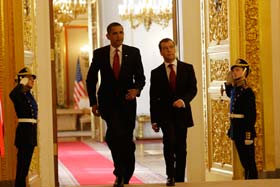Russian Media on Obama Visit: July 6

Theotherrussia.org provides translated excerpts from the Russian media coverage of US President Barack Obama’s visit to Moscow.
Much of the reporting has been serious and laudatory of the negotiations between Obama and Russian President Dmitri Medvedev.
The media also devoted a good deal of coverage to Barack Obama’s means of transport, devoting considerable attention to both the White House aircraft –Air Force One—, and the armored limo used to drive Obama through Moscow. Traffic jams caused by the visit were also heavily reported.
Read about the first day of meetings from Bloomberg.
—
State Run Television Channel 1:
“And today in Moscow, the presidents of the two countries signed new documents. This isn’t an agreement, but in substance a declaration of intent for reaching a final agreement. As the experts explain, today’s paper is not legally binding, but politically binding. Moscow has made it clear that it is linking the agreement with the problem of locating American Ballistic Missile Defense in Europe. Nonetheless, the sides are calling this document a breakthrough, because the previous US administration refused to discuss even the possibility of such an agreement.”
—
“If, all of a sudden, [Obama] was counting on a red carpet track and a wild mob of admirers, screaming something like “We love you!” in a Hollywood manner, then nothing of the sort awaited him in Moscow.”
—
Moskovsky Komsomolets Newspaper:
“While Dmitri Medvedev spoke, those in attendance could notice an interesting feature of Barak Obama’s behavior. During joint press-conferences, heads of state usually look from the podium into the room while their colleague is speaking, only rarely casting a glance at their counterpart. But the president of the US steadily looked at [Dmitri Anatolyevich Medvedev], as if trying to tell him: “I’m all ears.” One must admit: Obama was extremely charming in this manner.”
…
On the Missile Defense Shield:
“In whole, the American guest’s words sounded fairly contradictory: on the one hand, he admits that the defensive and offensive potential must be discussed in a single package. On the other hand, he says that placing Ballistic Missile Defense in Europe should not be seen as a threat to the Russian Federation. And in such a way notes the correlation between reducing strategic nuclear weapons and the fate of the system of anti-missile defense.
Yet the US has a suggestion: cooperate with Russia to create a system that would defend them from threats originating from third party states. An one time, [Prime Minister] Vladimir Putin repeatedly spoke out with the proposal to cooperate in the realm of anti-missile defense. However, the American administration at the time did not come half-way. The position of the current [administration], as we can see, has softened. Though it’s unclear what will come of it: Obama said, that this is a subject for more detailed negotiations.”
—
“The optimism demonstrated by the leaders of Russia and the US in opening the summit turned out to be justified: framework agreements on reducing offensive armaments were signed. The signed “Joint Understanding on Strategic Arms Reduction” defines the ceilings for reducing strategic arms and should become the basis for a new agreement on strategic nuclear weapons (SNW).”
…
RIA Novosti quotes two analysts in a section titled “Expert Opinion:”
Sergei Oznobishchev, director of the Institute for Strategic Evaluation:
“The meeting that took place is evidence that both presidents understand that it’s essential to move forward, and that solving international problems like nuclear disarmament, terrorism and others won’t happen if they act alone. Of course there are certain groups that will seriously interfere with the restoration of our relations, but if the presidents have enough wisdom and opportunities, then Russian-American relations are fated to a partnership.
One can avoid this partnership as long as possible, draw it out, bring the matter to nearly the Cold War, but without a partnership between the US and RF we will have trouble in this world.”
…
Sergei Karaganov, chairman of the presidium of the Russian Council on Foreign and Defense Policy, called the agreements an “absolute compromise:”
“What is being offered is the minimal reductions as compared with 2002 agreements, which limited the number of strategic reserve nuclear warheads of each side to 1700-2000 units. Both sides can now calmly reduce their warheads to this level, and 1675 units is a small reduction, and each side will be free, evidently, to reduce as much as is convenient.”
“Russia would prefer a deeper reduction in delivery vehicles, because this is economically to our advantage. The Americans, who can make the greater amount of vehicles, would want a less drastic reduction. They were prepared for a deeper reduction of warheads. This is a normal compromise, which suits both sides and leaves all options open, while the treaty question, the negotiations process and the schedule for limiting and reducing strategic offensive armaments receives a new impulse.”
translations by theotherrussia.org
